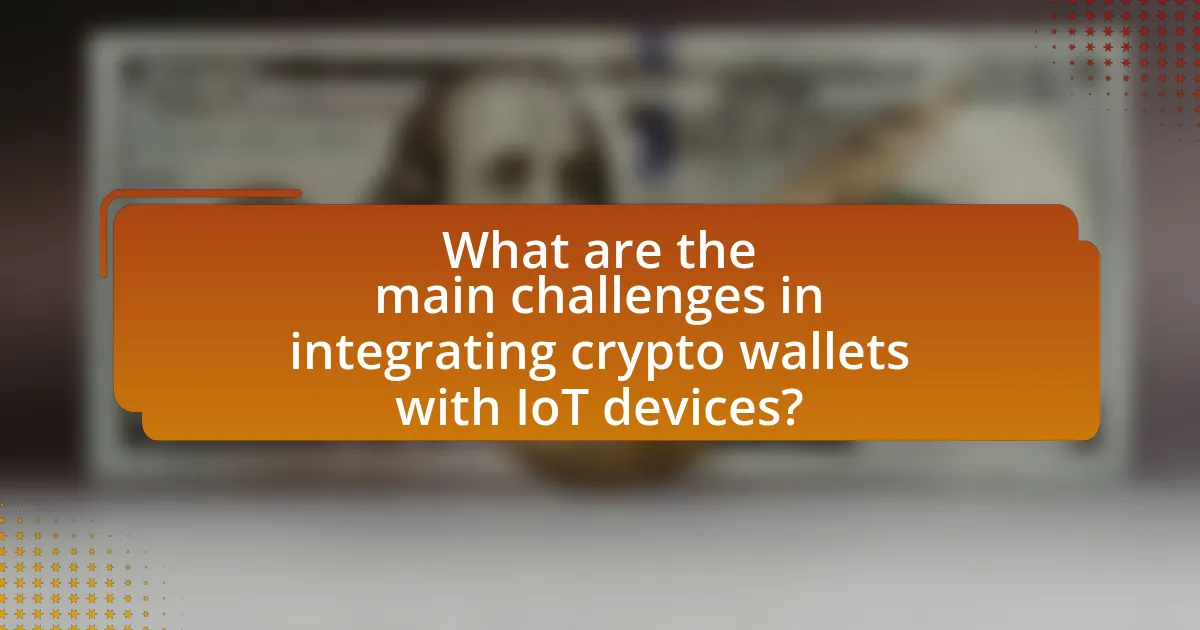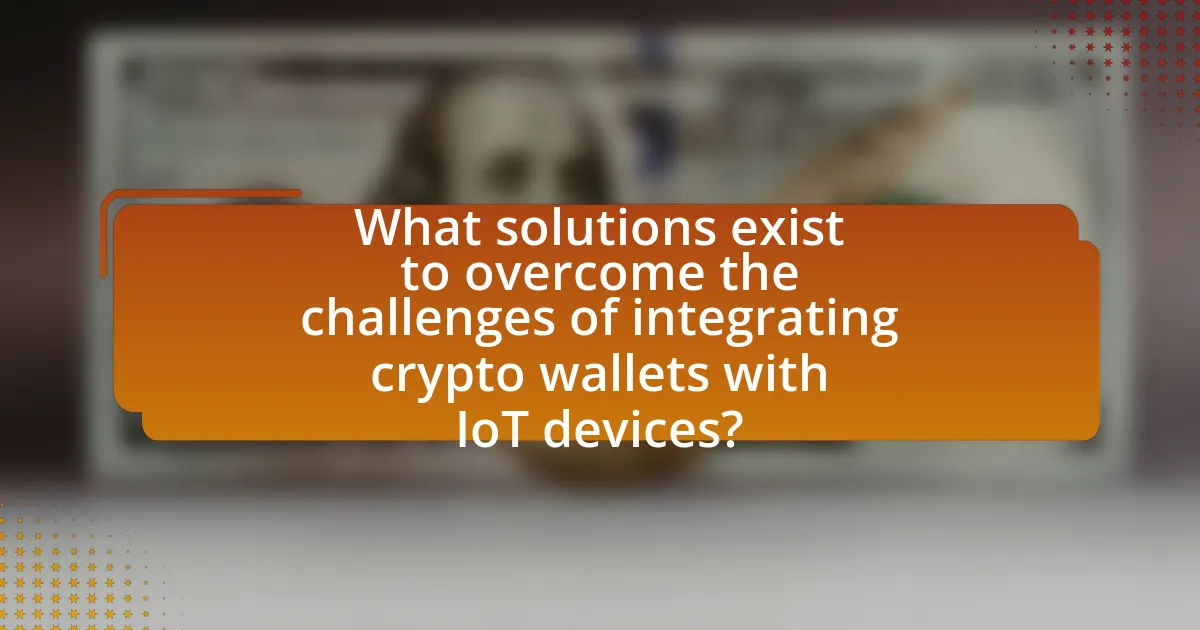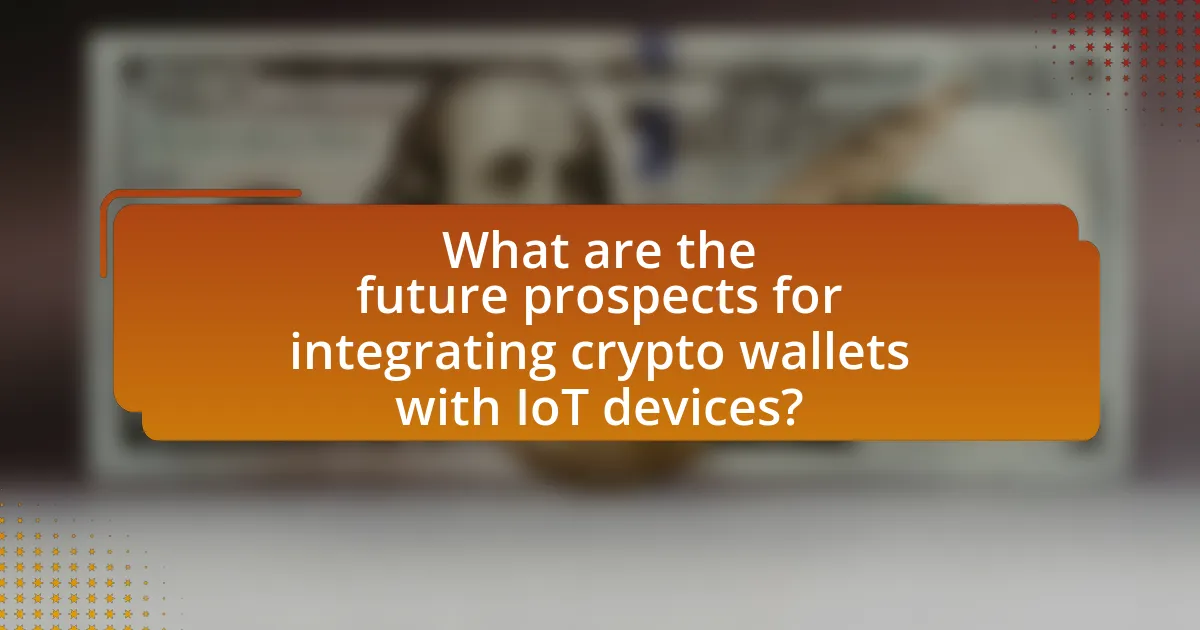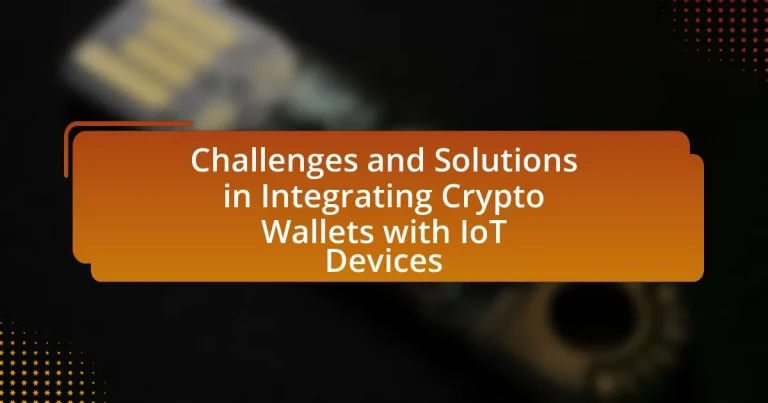The article focuses on the challenges and solutions associated with integrating crypto wallets with Internet of Things (IoT) devices. Key challenges include security vulnerabilities, scalability issues, interoperability concerns, and regulatory compliance. The article discusses prevalent security threats such as unauthorized access and data breaches, and outlines mitigation strategies like robust encryption and multi-factor authentication. Additionally, it highlights technical limitations, device compatibility issues, and the impact of emerging technologies such as blockchain and AI on enhancing integration. The future prospects for this integration are also explored, emphasizing the growing market for crypto-enabled IoT devices and the influence of consumer demands on development.

What are the main challenges in integrating crypto wallets with IoT devices?
The main challenges in integrating crypto wallets with IoT devices include security vulnerabilities, scalability issues, and interoperability concerns. Security vulnerabilities arise because IoT devices often have limited processing power and may not support robust encryption methods, making them susceptible to hacking and unauthorized access. Scalability issues occur as the number of IoT devices increases, leading to potential bottlenecks in transaction processing and network congestion. Interoperability concerns stem from the diverse range of IoT protocols and standards, which can complicate the seamless integration of crypto wallets across different devices and platforms. These challenges highlight the need for enhanced security measures, efficient transaction protocols, and standardized frameworks to facilitate integration.
How do security concerns impact the integration process?
Security concerns significantly hinder the integration process of crypto wallets with IoT devices by introducing complexities in data protection and user authentication. These concerns necessitate the implementation of robust encryption protocols and secure communication channels to prevent unauthorized access and data breaches. For instance, the 2020 IBM X-Force Threat Intelligence Index reported that 60% of IoT devices are vulnerable to attacks, highlighting the critical need for enhanced security measures during integration. Consequently, organizations must allocate additional resources and time to address these security challenges, which can delay the overall integration timeline and increase costs.
What types of security threats are prevalent in this integration?
The prevalent security threats in the integration of crypto wallets with IoT devices include unauthorized access, data breaches, and malware attacks. Unauthorized access occurs when attackers exploit vulnerabilities in IoT devices to gain control over crypto wallets, potentially leading to theft of digital assets. Data breaches can happen when sensitive information, such as private keys or transaction details, is intercepted during transmission or stored insecurely on devices. Malware attacks target IoT devices to manipulate or steal data, compromising the integrity of the crypto wallet. According to a report by the Cybersecurity & Infrastructure Security Agency (CISA), IoT devices are increasingly targeted due to their often inadequate security measures, making them attractive to cybercriminals.
How can these security threats be mitigated?
Security threats in integrating crypto wallets with IoT devices can be mitigated through robust encryption, regular software updates, and implementing multi-factor authentication. Encryption protects sensitive data by converting it into a secure format, making it unreadable to unauthorized users. Regular software updates ensure that vulnerabilities are patched, reducing the risk of exploitation. Multi-factor authentication adds an additional layer of security by requiring multiple forms of verification before granting access, which significantly decreases the likelihood of unauthorized access. These measures are supported by industry standards and best practices, such as the National Institute of Standards and Technology (NIST) guidelines, which emphasize the importance of security in IoT environments.
What technical limitations hinder the integration of crypto wallets with IoT devices?
Technical limitations that hinder the integration of crypto wallets with IoT devices include insufficient processing power, limited storage capacity, and inadequate security protocols. IoT devices often operate with minimal computational resources, making it challenging to run complex cryptographic algorithms required for secure transactions. Additionally, the storage limitations of these devices restrict the ability to maintain extensive blockchain data or wallet information. Furthermore, many IoT devices lack robust security measures, making them vulnerable to hacking and unauthorized access, which poses significant risks for managing crypto wallets. These factors collectively impede the seamless integration of crypto wallets into the IoT ecosystem.
How do connectivity issues affect the performance of crypto wallets in IoT?
Connectivity issues significantly hinder the performance of crypto wallets in IoT by disrupting transaction processing and data synchronization. When IoT devices experience poor connectivity, they struggle to communicate with blockchain networks, leading to delayed or failed transactions. For instance, a study by the International Journal of Information Management highlights that unreliable network connections can result in increased latency, which directly impacts the user experience and the wallet’s ability to execute timely transactions. Furthermore, intermittent connectivity can compromise the security of crypto wallets, as incomplete transactions may leave assets vulnerable to attacks. Thus, effective connectivity is crucial for maintaining the operational efficiency and security of crypto wallets in IoT environments.
What are the challenges related to device compatibility?
Device compatibility challenges primarily arise from the diverse operating systems, hardware specifications, and communication protocols used across IoT devices. These variations can lead to difficulties in ensuring that crypto wallets function seamlessly across different devices, as each device may have unique requirements for software integration and security measures. For instance, a study by the International Journal of Information Management highlights that over 70% of IoT devices operate on proprietary systems, complicating the standardization needed for effective wallet integration. Additionally, inconsistent firmware updates and varying levels of security across devices can further hinder compatibility, making it challenging for developers to create universally compatible solutions.
What regulatory and compliance issues arise during integration?
Regulatory and compliance issues that arise during the integration of crypto wallets with IoT devices include data privacy concerns, anti-money laundering (AML) regulations, and adherence to financial regulations. Data privacy laws, such as the General Data Protection Regulation (GDPR) in Europe, mandate strict guidelines on how personal data is collected, stored, and processed, which can complicate integration efforts. Additionally, AML regulations require that entities involved in cryptocurrency transactions implement measures to prevent illicit activities, necessitating robust identity verification processes. Furthermore, compliance with financial regulations, such as the Payment Services Directive (PSD2), is essential to ensure that the integration meets legal standards for payment processing and consumer protection. These regulatory frameworks create a complex landscape that organizations must navigate to achieve successful integration while remaining compliant.
How do varying regulations across regions affect integration efforts?
Varying regulations across regions significantly hinder integration efforts for crypto wallets with IoT devices. These regulations can create inconsistencies in compliance requirements, leading to increased complexity for developers and businesses attempting to implement solutions across multiple jurisdictions. For instance, the European Union’s General Data Protection Regulation (GDPR) imposes strict data privacy standards that differ from the more lenient regulations in some other regions, complicating the integration of IoT devices that handle sensitive user data. Additionally, differing tax implications and anti-money laundering (AML) laws can create barriers to seamless transactions, as companies must navigate a patchwork of legal frameworks to ensure compliance. This regulatory fragmentation can slow down innovation and increase costs, ultimately affecting the adoption and functionality of integrated systems.
What compliance standards must be considered for crypto wallets in IoT?
Compliance standards for crypto wallets in IoT include the General Data Protection Regulation (GDPR), the Payment Card Industry Data Security Standard (PCI DSS), and the Financial Action Task Force (FATF) guidelines. GDPR mandates the protection of personal data, ensuring that user information is handled securely. PCI DSS outlines security measures for payment transactions, which are crucial for crypto wallets handling financial data. FATF guidelines provide a framework for anti-money laundering (AML) and combating the financing of terrorism (CFT), which are essential for maintaining the integrity of crypto transactions. These standards collectively ensure that crypto wallets in IoT environments operate securely and comply with legal requirements.

What solutions exist to overcome the challenges of integrating crypto wallets with IoT devices?
Solutions to overcome the challenges of integrating crypto wallets with IoT devices include the implementation of secure hardware elements, the use of decentralized identity protocols, and the development of robust encryption methods. Secure hardware elements, such as Trusted Execution Environments (TEEs), provide a secure area within a device to store cryptographic keys, thereby enhancing security against unauthorized access. Decentralized identity protocols, like Self-Sovereign Identity (SSI), allow users to manage their identities and credentials securely, reducing the risk of data breaches. Additionally, robust encryption methods ensure that data transmitted between IoT devices and crypto wallets remains confidential and tamper-proof, addressing concerns related to data integrity and privacy. These solutions are supported by industry standards and best practices, which emphasize the importance of security in the integration of financial technologies with IoT systems.
How can enhanced security measures be implemented?
Enhanced security measures can be implemented by adopting multi-factor authentication, encryption protocols, and regular security audits. Multi-factor authentication adds an additional layer of security by requiring users to provide two or more verification factors to gain access, significantly reducing the risk of unauthorized access. Encryption protocols protect sensitive data during transmission and storage, ensuring that even if data is intercepted, it remains unreadable without the proper decryption keys. Regular security audits identify vulnerabilities and ensure compliance with security standards, allowing organizations to proactively address potential threats. These methods are supported by industry best practices, such as the National Institute of Standards and Technology (NIST) guidelines, which emphasize the importance of layered security approaches in safeguarding digital assets.
What role do encryption and authentication play in securing integrations?
Encryption and authentication are critical in securing integrations by ensuring data confidentiality and verifying the identity of users and devices. Encryption protects sensitive information transmitted between crypto wallets and IoT devices, making it unreadable to unauthorized parties. For instance, using AES (Advanced Encryption Standard) can secure data in transit, preventing interception and tampering. Authentication, on the other hand, establishes trust by confirming that the entities involved in the integration are legitimate. Techniques such as OAuth and digital certificates are commonly employed to authenticate users and devices, ensuring that only authorized parties can access or interact with the system. Together, these mechanisms create a robust security framework that mitigates risks associated with data breaches and unauthorized access in the integration of crypto wallets with IoT devices.
How can multi-signature wallets improve security in IoT applications?
Multi-signature wallets can significantly enhance security in IoT applications by requiring multiple private keys to authorize a transaction, thereby reducing the risk of unauthorized access. This mechanism ensures that even if one key is compromised, the transaction cannot proceed without the additional keys, which are typically held by different parties or devices. For instance, in a smart home environment, a multi-signature wallet could require approval from both the homeowner and a trusted service provider before executing any financial transaction, thus adding an extra layer of verification. This approach mitigates risks associated with single points of failure and enhances overall security by distributing control among multiple stakeholders.
What technological advancements facilitate better integration?
Technological advancements that facilitate better integration of crypto wallets with IoT devices include blockchain technology, secure communication protocols, and artificial intelligence. Blockchain technology provides a decentralized and secure ledger for transactions, ensuring transparency and trust in the integration process. Secure communication protocols, such as MQTT and CoAP, enable efficient and safe data exchange between IoT devices and crypto wallets, reducing the risk of data breaches. Artificial intelligence enhances integration by enabling smart contract automation and real-time decision-making, improving the overall efficiency of transactions. These advancements collectively address the challenges of security, interoperability, and scalability in integrating crypto wallets with IoT devices.
How do blockchain technologies enhance the functionality of IoT devices?
Blockchain technologies enhance the functionality of IoT devices by providing secure, decentralized data management and enabling trustless transactions. This security is achieved through cryptographic techniques that ensure data integrity and authenticity, which is crucial for IoT devices that often operate in untrusted environments. For instance, a study by IBM highlights that blockchain can reduce the risk of data tampering and unauthorized access, thereby improving the overall security posture of IoT networks. Additionally, blockchain facilitates seamless peer-to-peer communication among devices, allowing for automated transactions without the need for intermediaries, which can significantly enhance operational efficiency.
What innovations in IoT hardware support crypto wallet integration?
Innovations in IoT hardware that support crypto wallet integration include secure element chips, hardware security modules (HSMs), and advanced encryption technologies. Secure element chips provide a tamper-resistant environment for storing cryptographic keys, ensuring that sensitive data remains protected during transactions. Hardware security modules enhance security by managing and storing cryptographic keys in a dedicated hardware device, which is crucial for secure wallet operations. Additionally, advanced encryption technologies, such as end-to-end encryption and blockchain integration, facilitate secure communication between IoT devices and crypto wallets, reducing the risk of unauthorized access and fraud. These innovations collectively enhance the security and functionality of crypto wallet integration in IoT ecosystems.
What best practices should be followed for regulatory compliance?
To ensure regulatory compliance, organizations should implement a comprehensive compliance program that includes regular risk assessments, employee training, and adherence to relevant laws and regulations. Regular risk assessments help identify potential compliance gaps, while employee training ensures that staff are aware of compliance requirements and best practices. Adhering to laws such as the General Data Protection Regulation (GDPR) and the Financial Action Task Force (FATF) guidelines is crucial for maintaining compliance in the rapidly evolving landscape of crypto wallets and IoT devices. These practices are supported by the fact that organizations with robust compliance programs are less likely to face legal penalties and reputational damage, as evidenced by studies showing that effective compliance can reduce the risk of fines by up to 30%.
How can organizations stay updated with changing regulations?
Organizations can stay updated with changing regulations by implementing a robust compliance management system that includes regular monitoring of regulatory updates, engaging with legal experts, and utilizing technology for real-time alerts. This approach ensures that organizations can quickly adapt to new laws and guidelines, which is crucial in the rapidly evolving landscape of cryptocurrency and IoT integration. For instance, the Financial Action Task Force (FATF) regularly publishes guidance on cryptocurrency regulations, which organizations can subscribe to for timely updates.
What frameworks can assist in ensuring compliance during integration?
Several frameworks can assist in ensuring compliance during integration, including the General Data Protection Regulation (GDPR), the Payment Card Industry Data Security Standard (PCI DSS), and the NIST Cybersecurity Framework. GDPR provides guidelines for data protection and privacy, particularly in handling personal data, which is crucial when integrating crypto wallets with IoT devices. PCI DSS outlines security measures for payment transactions, ensuring that financial data is handled securely. The NIST Cybersecurity Framework offers a structured approach to managing cybersecurity risks, which is essential for maintaining compliance in the rapidly evolving landscape of IoT and cryptocurrency. These frameworks collectively help organizations adhere to legal and regulatory requirements while integrating technologies.

What are the future prospects for integrating crypto wallets with IoT devices?
The future prospects for integrating crypto wallets with IoT devices are promising, driven by advancements in security, interoperability, and user convenience. As IoT devices proliferate, the demand for secure and efficient transactions will increase, leading to the development of crypto wallets that can seamlessly interact with these devices. For instance, the integration of blockchain technology can enhance security by providing decentralized verification of transactions, reducing the risk of fraud. Additionally, the rise of smart contracts can automate transactions between IoT devices and crypto wallets, streamlining processes in sectors like supply chain management and smart homes. According to a report by MarketsandMarkets, the IoT market is expected to grow from $250 billion in 2019 to over $1 trillion by 2025, indicating a significant opportunity for crypto wallet integration.
How is the market for crypto-enabled IoT devices evolving?
The market for crypto-enabled IoT devices is rapidly expanding, driven by increasing demand for secure transactions and enhanced data privacy. According to a report by MarketsandMarkets, the global IoT market is projected to grow from $381.3 billion in 2021 to $1.1 trillion by 2026, with a significant portion of this growth attributed to the integration of blockchain technology for secure data exchange. This integration allows IoT devices to utilize decentralized networks, improving security and reducing the risk of data breaches. Furthermore, the rise of smart contracts and decentralized applications is facilitating seamless interactions between IoT devices and cryptocurrency wallets, enhancing user experience and operational efficiency.
What trends are shaping the future of this integration?
The trends shaping the future of integrating crypto wallets with IoT devices include increased security measures, enhanced interoperability, and the rise of decentralized finance (DeFi) applications. Increased security measures are driven by the need to protect sensitive financial data, with advancements such as biometric authentication and blockchain-based security protocols gaining traction. Enhanced interoperability is essential for seamless communication between various IoT devices and crypto wallets, leading to the development of standardized protocols and APIs. The rise of DeFi applications is pushing the integration of crypto wallets into IoT ecosystems, enabling smart contracts and automated transactions, which are projected to grow significantly, with the DeFi market reaching over $100 billion in total value locked by 2023. These trends indicate a shift towards more secure, efficient, and user-friendly integration of crypto wallets with IoT devices.
How do consumer demands influence the development of crypto wallets for IoT?
Consumer demands significantly influence the development of crypto wallets for IoT by driving the need for enhanced security, user-friendly interfaces, and interoperability. As consumers increasingly adopt IoT devices, they expect crypto wallets to provide seamless integration with these devices, ensuring secure transactions and easy access to digital assets. For instance, a survey by Deloitte in 2021 indicated that 60% of consumers prioritize security features in digital wallets, prompting developers to focus on advanced encryption and multi-factor authentication. Additionally, the demand for intuitive user experiences has led to the creation of wallets that simplify the transaction process, catering to non-technical users. This alignment with consumer expectations shapes the features and functionalities of crypto wallets, ultimately influencing their design and development in the IoT ecosystem.
What role will emerging technologies play in this integration?
Emerging technologies will facilitate the integration of crypto wallets with IoT devices by enhancing security, interoperability, and user experience. For instance, blockchain technology provides a decentralized and secure framework for transactions, reducing the risk of fraud and ensuring data integrity. Additionally, advancements in artificial intelligence can optimize transaction processing and user authentication, making interactions seamless and efficient. According to a report by Gartner, the adoption of blockchain in IoT applications is expected to grow significantly, with projections indicating that by 2025, over 20% of IoT devices will utilize blockchain for secure transactions. This demonstrates the critical role that emerging technologies play in addressing the challenges of integrating crypto wallets with IoT devices.
How might AI and machine learning enhance security and functionality?
AI and machine learning can enhance security and functionality by enabling real-time threat detection and adaptive response mechanisms. These technologies analyze vast amounts of data from IoT devices to identify patterns indicative of security breaches, allowing for immediate action to mitigate risks. For instance, machine learning algorithms can learn from historical attack data to predict and prevent future vulnerabilities, significantly reducing the likelihood of unauthorized access to crypto wallets. Additionally, AI can automate security protocols, ensuring consistent and efficient monitoring of device interactions, which is crucial in the dynamic environment of IoT. This integration of AI and machine learning not only strengthens security measures but also improves the overall functionality of crypto wallets by providing seamless user experiences and enhanced transaction verification processes.
What impact will 5G technology have on the integration of crypto wallets with IoT?
5G technology will significantly enhance the integration of crypto wallets with IoT by providing faster data transfer speeds, lower latency, and improved connectivity. These advancements enable real-time transactions and seamless communication between IoT devices and crypto wallets, facilitating efficient payment processing and enhancing user experience. For instance, 5G networks can support a higher density of connected devices, allowing for more simultaneous transactions, which is crucial for applications like smart cities and automated supply chains. This capability is backed by the expected global rollout of 5G, which is projected to reach over 1.7 billion connections by 2025, according to the GSMA.
What practical steps can businesses take to successfully integrate crypto wallets with IoT devices?
Businesses can successfully integrate crypto wallets with IoT devices by implementing secure APIs, ensuring robust encryption, and utilizing blockchain technology for transaction verification. Secure APIs facilitate communication between IoT devices and crypto wallets, allowing for seamless transactions. Robust encryption protects sensitive data during transmission, mitigating risks of hacking or data breaches. Utilizing blockchain technology enhances transparency and security, as each transaction is recorded on a decentralized ledger, making it tamper-proof. These steps are essential for maintaining user trust and ensuring compliance with regulatory standards in the rapidly evolving landscape of digital currencies and IoT.
What are the key considerations for businesses before starting integration?
Key considerations for businesses before starting integration include assessing technical compatibility, understanding regulatory requirements, ensuring data security, and evaluating user experience. Technical compatibility is crucial as it determines whether existing systems can effectively communicate with new technologies. Regulatory requirements must be understood to comply with laws governing cryptocurrency and IoT devices, which can vary significantly by region. Data security is paramount, as integrating crypto wallets with IoT devices can expose vulnerabilities; businesses must implement robust security measures to protect sensitive information. Lastly, evaluating user experience is essential to ensure that the integration meets customer needs and enhances usability, which can drive adoption and satisfaction.
How can businesses effectively test and validate their integrations?
Businesses can effectively test and validate their integrations by implementing a structured approach that includes unit testing, integration testing, and user acceptance testing. Unit testing focuses on individual components to ensure they function correctly, while integration testing assesses the interaction between different systems, such as crypto wallets and IoT devices. User acceptance testing involves end-users to confirm that the integration meets their needs and expectations.
Additionally, utilizing automated testing tools can enhance efficiency and accuracy, allowing for continuous integration and deployment practices. According to a study by the International Journal of Information Management, organizations that adopt automated testing report a 30% reduction in testing time and a 25% increase in defect detection rates. This structured and data-driven approach ensures that integrations are robust, reliable, and ready for deployment.


